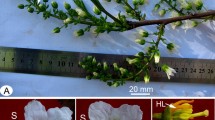Summary
Staminate flowers of the Acorn squash (Cucurbita pepo, cv. Table Queen) are initiated monosexually, pistillate flowers are initiated bisexually. Pistillate flower primordia are physiologically bisexual from a stage below 0.3 mm until they are 0.8 mm in width.
Male and female floral buds were cultivated on White's medium, modified according to Galun et al. (1963). In excised female floral buds the relative development of stamens is better than in in-situ floral buds; the opposite relationship holds for ovary development. The smaller the bud at excision, the greater the stamen growth and the lesser the ovary growth, both in absolute and relative terms. Although smaller pistillate floral buds cultured in vitro showed a greater increase in maleness than larger ones, there was no difference in the percentage of female buds between explants of the two sizes when originating from the “mixed” stem region (that is, the stem region carrying male and female flowers). Addition of 3-indoleacetic acid and the anti-auxin p-chlorophenoxyisobutyric acid to standard medium in equal amounts resulted in somewhat better development of excised floral buds than addition of each of these compounds alone.
The percentage of female buds among explants originating from identical nodes was not significantly influenced by 3-indoleacetic acid or p-chlorophenoxyisobutyric acid.
Similar content being viewed by others
References
Atsmon, D., and E. Galun: A morphogenetic study of staminate, pistillate and hermaphrodite flowers in Cucumis sativus (L.). Phytomorphology 10, 110–115 (1960).
Bélanger, L. F., and C. P. Leblond: A method for locating radioactive elements in tissues by covering histological sections with a photographic emulsion. Endocrinology 39, 8–13 (1946).
Burstrøm, H.: Studies on growth and metabolism of roots. IV. Positive and negative auxin effects on cell elongation. Physiol. Plantarum (Cph.) 3, 277–292 (1950).
Galun, E.: Effects of gibberellic acid and naphthaleneacetic acid on sex expression and some morphological characters in the cucumber plant. Phyton (Argentina) 13, 1–6 (1959).
—: Study of the inheritance of sex expression in the cucumber. The interaction of major genes with modifying genetic and non-genetic factors. Genetica 32, 134–163 (1961).
— Y. Jung and A. Lang: Morphogenesis of floral buds of cucumber cultured in vitro. Develop. Biol. 6, 370–387 (1963).
Kefford, N. P.: Auxin-gibberellin interaction in rice coleoptile elongation. Plant Physiol. 37, 380–386 (1962).
Laibach, F., u. F. J. Kribben: Der Einfluß von Wuchsstoff auf die Bildung männlicher und weiblicher Blüten bei einer monözischen Pflanze (Cucumis sativus L.). Ber. dtsch. bot. Ges. 62, 53–55 (1950).
——: Der Einfluß von Wuchsstoff auf das Geschlecht der Blüten bei einer monözischen Pflanze. Beitr. Biol. Pflanz. 28, 64–67 (1951).
Libbert, E.: Die Regulation des Wurzelwachstums durch synthetische und endogene Inhibitoren. Planta (Berl.) 50, 25–40 (1957).
McRae, D. H., and J. Bonner: Chemical structure and antiauxin activity. Physiol. Plantarum (Cph.) 6, 485–510 (1953).
Nitsch, J.-P., E. B. Kurtz, J. L. Liverman, and F. W. Went: The development of sex expression in Cucurbit flowers. Amer. J. Bot. 39, 32–43 (1952).
Prescott, D. M.: Autoradiography with liquid emulsion. In: Methods in cell physiology (D. M. Prescott, ed.), vol. 1, p. 365–370. New York and London: Academic Press Inc. 1964.
Tkachenko, N. N.: Preliminary results of genetic investigation of the cucumber — Cucumis sativus L. [Russ. with Engl. summary]. Bull. appl. Bot., Genet., Pl. Breed. II 9, 311–356 (1935).
Wittwer, S. H., and M. J. Bukovac: The effect of gibberellin on economic crops. Econ. Bot. 12, 213–255 (1958).
Author information
Authors and Affiliations
Additional information
Weizmann Memorial Fellow. The studies reported in this publication were mainly undertaken at the Weizmann Institute of Science
Rights and permissions
About this article
Cite this article
Pereira, A.S.R. Sex expression in floral buds of Acorn squash. Planta 80, 349–358 (1968). https://doi.org/10.1007/BF00385388
Received:
Issue Date:
DOI: https://doi.org/10.1007/BF00385388




